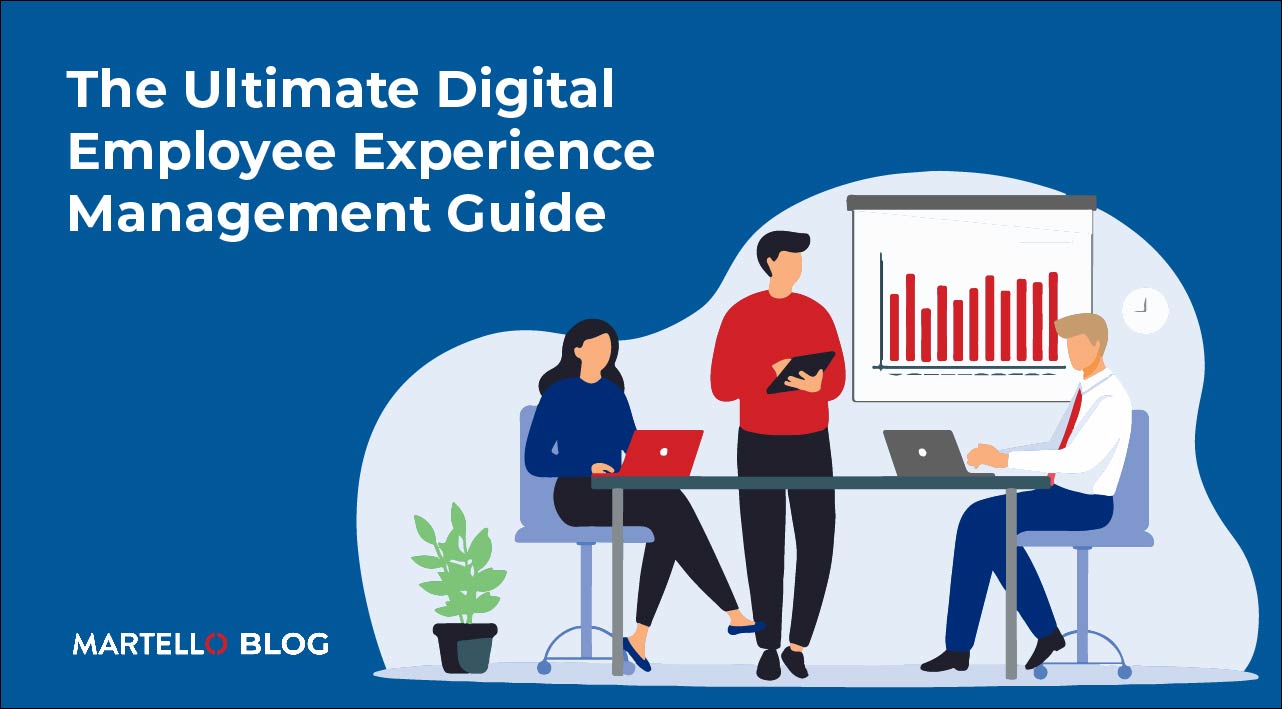The Ultimate Digital Employee Experience Management Guide
Uncategorized
In 2024, the overall employee experience hinges, in large part, on the quality of their digital interactions. Digital Employee eXperience (DEX) encompasses all digital touchpoints between employees and their work environment and aims to enhance satisfaction, engagement, and productivity across any digital touchpoint.
Whether it’s UI design and accessibility or performance and security, DEX focuses on providing the tools and resources employees need to perform their tasks to the best of their ability with technology not being hidden, but actually empowering them. 
Optimizing DEX is crucial for modern organizations if they want to increase productivity, improve employee satisfaction, and reduce downtime. Effective DEX strategies streamline workflows, enable faster decision-making, and foster a positive work culture by giving employees reliable and intuitive digital tools.
This guide dives into the core components of DEX, highlighting the importance of key elements like intuitive design, robust security, and high-performing systems that all come together to create an environment of seamless digital communication and collaboration.
What Constitutes Digital Employee Experience?
DEX encompasses the whole spread of digital interactions and touchpoints between employees and their workplaces. At its core, DEX focuses on providing employees with the necessary digital tools and resources to perform their jobs more efficiently. This involves hardware and software systems, communication platforms, and collaboration tools, all aimed at simplifying tasks, automating processes, and minimizing the friction between different digital workflows.
DEX has five key components:
- UI Design: Intuitive and user-friendly interfaces that enhance ease of use.
- Accessibility: Making sure every employee, regardless of their technical ability, can access and use digital tools.
- Performance: Systems that minimize downtime and latency for these critical digital tools and also empower performance insight.
- Security: Robust security measures that protect digital assets and employee data
- Usability: Tools that are easy to learn and use, and improve overall employee satisfaction.
The metrics used to measure the key components of DEX vary between organizations, but common metrics include the speed of support, application load times, live fault levels, and how current anti-malware updates are. Any measure of each of the five key components can be combined to create a DEX score. The more metrics available, the more accurate that reading is going to be.
To get deeper into the topic of measurement and answer the question ‘what is digital experience monitoring?’ check out our previous article on the topic.
The Benefits of Optimizing Digital Employee Experience
With so many different facets of DEX to be explored, let’s zoom out for a moment and take a look at what improving DEX can do for organizations.
Increased Productivity and Efficiency
Optimizing DEX can significantly boost productivity and efficiency. According to the research report by EMA, The Evolution of Work: Enhancing Productivity and Collaboration through Digital Employee Experience (DEX), of the 1,000 US organizations from a wide variety of industries surveyed, 28% reported faster decision-making as a direct result of implementing a DEX strategy and solution.
The wins don’t stop there – 24% of those organizations also report gains in operational efficiency. By leveraging DEX strategies and solutions to help employees to work smarter and not harder, a range of improvements can be made throughout businesses. Monitoring DEX solutions can extend these gains to ensure uninterrupted productivity and efficiency. You can learn more about digital experience monitoring ROI here.
For some system-specific context, 81% of those organizations believe that the product that enhances DEX in their organization was Microsoft 365 and Teams, followed by Zoom, and then Google Workspace.
Enhanced Employee Satisfaction and Retention
A positive digital employee experience directly correlates with higher employee satisfaction and retention. When employees have access to reliable and intuitive digital tools, their job satisfaction increases, leading to higher engagement and loyalty.
 The EMA report highlights that 91% of IT managers agree or strongly agree that implementing a DEX solution was worthwhile for the organization, underscoring the value of a well-managed digital environment in retaining top talent.
The EMA report highlights that 91% of IT managers agree or strongly agree that implementing a DEX solution was worthwhile for the organization, underscoring the value of a well-managed digital environment in retaining top talent.
Reduced Downtime and Faster Issue Resolution
Effective DEX management reduces downtime and facilitates faster issue resolution. By leveraging monitoring tools and proactive digital management strategies, organizations can identify and address IT issues before they impact employees. The EMA report indicates that unified endpoint management (UEM) systems are critical for ensuring seamless integration and the management of digital tools across the organization, ultimately enhancing the DEX. If you’re not sure how together your digital immune system is, then check out this article.
Key Challenges in Digital Employee Experience Management
After putting a DEX strategy and solution in place, implementing Digital Employee Experience Management (DEEM), isn’t quite as easy as organizations might first hope: because it’s deeply integrated into so many existing workflows. With that said, the key challenges in digital employee experience management can be tackled if worked on in the right way.
Integration Complexity
Managing the integration of diverse cloud-based systems and applications can be challenging because of compatibility issues and differing protocols. Guaranteeing a seamless DEX requires a cohesive integration strategy that addresses these challenges. You’ll find in the EMA report that integration complexity is a significant barrier to productivity, which means prioritizing solutions that integrate natively is key.
Scalability and Performance
Maintaining consistent performance and scalability of digital tools is crucial as organizations grow. Without proper planning, user experience can degrade – leading to increased frustration and decreased productivity. Effective DEX management must account for scaling digital tools to meet the needs of a growing workforce while still maintaining high performance. This requires a long-term understanding of where a business is headed, how it’s going to get there, and with which technologies.
Security and Compliance
Keeping up with the security of digital assets and making sure you’re compliant with regulations is a constant challenge. Organizations must implement vigilant security measures to protect against threats and adhere to privacy laws. Data security and privacy concerns are such a major potential inhibitor to productivity that they are the number one concern for businesses using IT services. That should tell you all you need to know about how important they are.
User Adoption and Training
Overcoming the natural resistance to change in any workforce is always a challenge – whatever you’re implementing. You have to make sure user training is well-guided and constantly accessible, for the implementation and utilization of digital solutions to be a success. Good training has a direct impact on employee satisfaction and the overall cultural adoption of a new way of working.
Strategies for Effective Digital Employee Experience Management

The strategies for effective DEEM are ones that seek to solve the challenges we’ve just listed. Consideration should be given to how key those particular challenges are in your own organization, as you may already have other initiatives in place to solve them – at least in part.
Proactive Monitoring and Management
Implementing tools and processes for proactive monitoring and management is essential to detect and address IT issues before they impact employees. Martello provides comprehensive monitoring solutions that offer real-time visibility into the performance of Microsoft Teams, allowing IT teams to resolve issues proactively and guarantee every workflow maintains constant uptime. In 2024, reliable digital communication can only be achieved with the support of monitoring tools like Vantage DX.
Enhancing System Reliability
Enhancing system reliability involves implementing redundancy measures and conducting regular maintenance to cut down on system downtime. Regular updates and checks will mean that digital resources are always available and functioning in full are a must. One section of the EMA report demonstrated the importance of reliable systems in maintaining productivity and employee satisfaction. Simply put, if it’s offline, no one can use it – not good for DEX.
Improving User Support
Improving user support means you need to implement automated solutions and efficient incident management processes to provide rapid assistance to anyone who needs it. Automated support systems can handle common issues quickly, while more complex problems are escalated to IT teams for resolution. The step beyond this is a more proactive approach that takes into account the best practices in incident management. This approach ensures that employees receive the help they need without significant delays, or even better, before they know something is wrong.
Ensuring Security and Compliance
Implementing robust cybersecurity measures and sticking to industry standards is crucial for protecting employee data and maintaining regulatory compliance. That’s why those standards are there. It involves regular security audits, employing advanced threat detection systems, and using all digital tools that exclusively comply with laws and regulations relevant to your business.
Tools and Technologies for Digital Employee Experience Management
To support those strategies, you need technology that enables you to hit your DEEM goals and there are several key categories that you should focus on to start with.
Monitoring and Analytics Tools
Monitoring and analytics tools enable real-time tracking and analysis of digital systems, facilitating proactive identification and resolution of issues. Martello offers a digital experience monitoring tool built specifically for MS365 and Teams. It offers users total visibility into digital experiences from end to end, helping organizations enhance employee experience through effective monitoring and insight– led action.
IT Service Management (ITSM) Tools
IT service management tools streamline IT processes and workflows, meaning businesses can provide the efficient delivery of services and support to employees. These tools help manage incidents, changes, and service requests, providing a seamless digital experience for employees. People need a place to report issues, not only so that your IT teams can help them, but so you can track the levels of service – a key concept of DEEM.

Collaboration and Communication Tools
Collaboration and communication tools are key to smooth interactions and teamwork among employees – particularly in the age of hybrid work. The hybrid workplace is a growing constant, and organizations that don’t pay attention to supporting it will be left behind.
DEEM Transformation in The DWP
The Department for Work and Pensions (DWP) is responsible for welfare, pensions, and child maintenance policy across the UK. As the UK’s biggest public service department, it administers the State Pension and a range of working-age, disability, and ill health benefits to around 20 million claimants and customers. They have over 100,000 staff and approximately 1,000 sites across the UK.
The Problem
The DWP relies heavily on Microsoft 365 for internal and external communication, with Outlook and Teams being critical. With millions of calls and meetings monthly, disruptions severely impact productivity. Native Microsoft tools often only alerted issues when reported by users, which got in the way of rapid resolution. The DWP faced challenges in monitoring performance across their various sites and wanted to detect and act on issues proactively, especially during significant IT changes like deploying Teams Telephony.
The Solution
The DWP implemented Martello’s Vantage DX for proactive Microsoft 365 and Teams monitoring. Vantage DX uses synthetic transactions to simulate user actions, enabling early detection of issues. The tool’s diagnostics capabilities allowed DWP to visualize and troubleshoot issues efficiently. Vantage DX also provided performance metrics and user experience data in a centralized KPI dashboard for senior leadership. This set the standard for other UK government bodies.
The Outcome
Vantage DX enhanced the DWP’s Microsoft monitoring to meet critical system standards. The tool enabled proactive issue detection and rapid outage resolution, improving service delivery. Vantage DX streamlined network change management, reducing the need for extensive testing and lowering support costs.
Future Trends in Digital Employee Experience Management
DEEM is a reasonably new concept, so it’s natural that its development is currently happening at pace. Now, DEEM professionals are looking for ways to include adjacent technologies that can help benefit the digital employee experience.
AI and Machine Learning in IT Management
AI and machine learning in IT management are beginning to use advanced algorithms to predict issues, automate resolutions, and improve overall system efficiency. By analyzing patterns and data trends, these technologies can foresee potential system failures or performance bottlenecks and take preemptive actions to mitigate them. This proactive approach minimizes downtime and ensures a smoother digital experience for employees. When it comes to reliable digital communication Vantage DX’s synthetic testing is a big part of this future. In fact, the Martello AI Strategy is designed to embed even more powerful analytics and proactive problem-solving into the DEEM approach, relieving the IT burden.
and take preemptive actions to mitigate them. This proactive approach minimizes downtime and ensures a smoother digital experience for employees. When it comes to reliable digital communication Vantage DX’s synthetic testing is a big part of this future. In fact, the Martello AI Strategy is designed to embed even more powerful analytics and proactive problem-solving into the DEEM approach, relieving the IT burden.
Integration of IoT for Enhanced Monitoring
The integration of IoT for monitoring allows real-time data collection and analysis, providing deeper insights into system performance and employee interactions with digital tools. IoT devices can monitor various parameters such as network latency, device health, and usage patterns, offering a comprehensive view of digital environments at a hyper-local level. This data helps IT teams, as part of incident management best practices, make informed decisions and quickly address any anomalies that might affect employee productivity – particularly when they’re working outside the office.

Rise of Remote and Hybrid Work Environments
The rise of remote and hybrid work environments requires adapting digital tools to offer flexibility, seamless connectivity, and sustained productivity for a distributed workforce. Organizations must invest in effective collaboration platforms, secure remote access solutions, and communication tools to truly support their employees. As highlighted in the EMA report, ensuring that remote workers have the same level of access and experience as their in-office counterparts is critical for maintaining productivity and engagement.
Final Thoughts and Recommendations
Digital employee experience management is essential for modern workplaces because it improves productivity, employee satisfaction, and organizational efficiency – all key drivers for revenue. Those key components of DEX, UI design, accessibility, performance, security, and usability, and the strategies that are developed to support them will separate the businesses that are successful in the age of hybrid from those that fall by the wayside.
Investing in quality tools and systems is critical for providing a seamless digital experience. Platforms like Martello’s Vantage DX offer comprehensive solutions for monitoring and managing Microsoft 365 and Teams, helping IT teams address issues proactively and maintain top-tier system performance.
Organizations should continuously evaluate their digital employee experience and look for ways to improve it. By leveraging future technologies such as AI, machine learning, and IoT, and adapting to the evolving needs of remote and hybrid work environments, businesses can create a more productive and satisfying workplace for their employees.
If DEX and DEEM are on your agenda, and you want to know more, then read the full EMA report The Evolution of Work: Enhancing Productivity and Collaboration through Digital Employee Experience (DEX), by getting in touch with Martello today.


